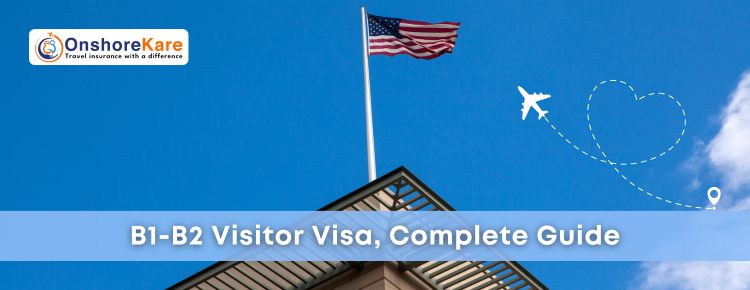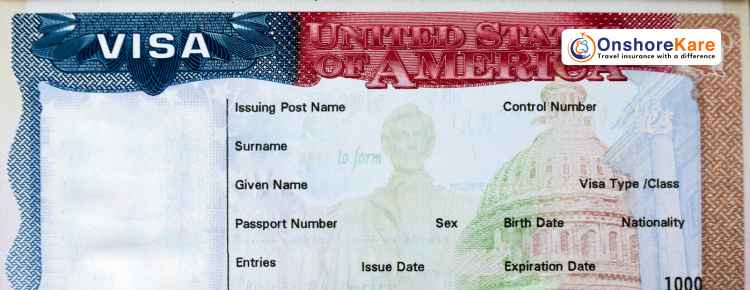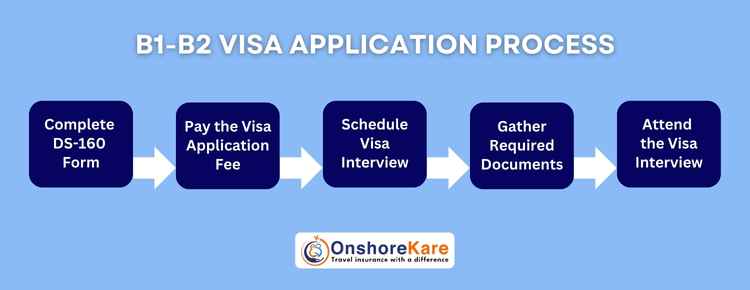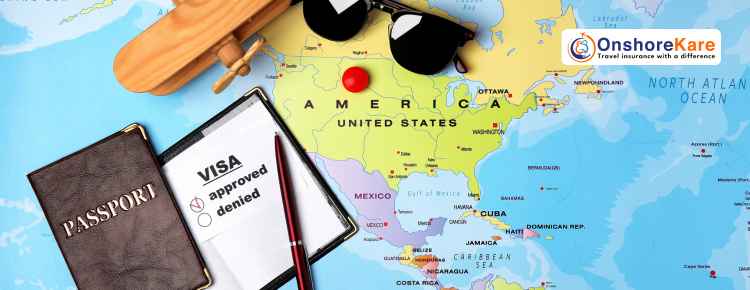
USA Visitor Visa | Applying For A B2 Visa
The B1 B2 visa popularly known as the visitor visa or tourist visa is one of the most in-demand visa types.
Among the most common nonimmigrant visas are the B1 and B2 visas, which cater to different purposes but often overlap in their application and usage.
This comprehensive guide will focus on providing detailed information about the application process, necessary documentation, and other essential details to ensure your application process is smooth and hassle-free.
Understanding The B1-B2 Visa
You need a business (B1) or tourist visa (B2) to travel to the United States temporarily for business or pleasure.
A large number of tourist visa applications get denied due to a lack of proper documentation or a legitimate reason to visit the United States.
Hence preparation for the visa process helps in a successful application.
The visitor visa (B2) is a nonimmigrant visa designed for individuals visiting the United States temporarily for tourism, medical treatment, or visiting family members and friends.
This visa category is part of the broader B1/B2 visa, which also includes the B1 Visa for business purposes.
Parents visiting the USA need to obtain this visitor visa, and this complete guide on parents’ visitor visas is helpful.

Key Features Of The B2 Visa
- Purpose: Tourism, social events, medical treatment, and visiting family or friends.
- Duration: Typically up to 6 months per visit, though it can vary based on the consular officer’s decision.
- Multiple Entry Visa: Allows multiple entries into the United States during the visa’s validity period.
- Validity: Can range from 1 to 10 years, depending on the applicant’s home country and other factors.
Application Process For The B2 Visa

Applying for a visitor Visa involves several steps, each requiring careful attention to detail. Here’s a step-by-step guide to help you navigate the process:
1. Complete The DS-160 Form
The DS-160 Form, also known as the Online Nonimmigrant Visa Application form, is the first step in the application process. It collects information about your travel plans, background, and purpose of visit.
- Access the Form: Visit the U.S. Department of State’s Consular Electronic Application Center (CEAC) to complete the DS-160 form.
- Information Required: Personal details, travel itinerary, background information, and passport details.
- Confirmation Page: After submitting the form, print the confirmation page with the barcode, which is required for the visa interview.
2. Pay The Visa Application Fee
The next step is to pay the non-refundable visa application fee. The fee amount varies depending on your country of residence but generally falls around $160.
- Payment Methods: Online payment, bank transfer, or in-person payment at designated banks.
- Receipt: Retain the payment receipt as proof, as it is needed for the visa interview.
3. Schedule The Visa Interview
Scheduling a visa interview at the nearest U.S. embassy or consulate is a crucial part of the process. The wait time for interview appointments can vary, so it’s advisable to schedule early.
- Appointment Wait Time: Check the current wait times for interviews at your selected embassy or consulate.
- Confirmation Page: Have the DS-160 confirmation page, payment receipt, and passport ready when scheduling the appointment.
4. Gather Required Documents
Prepare a set of documents to present during your visa interview. These documents help establish your eligibility and intent to return to your home country after your visit.
- Passport Validity: Ensure you have a passport valid for at least six months beyond your intended stay in the United States.
- Photograph: A recent passport-sized photograph that meets U.S. visa photo requirements
- Travel Plans: Detailed itinerary including flight bookings and accommodation reservations
- Proof of Funds: Bank statements or financial documents demonstrating sufficient funds to cover your stay
- Ties to Home Country: Documents proving your intent to return to your home country, such as employment letters, property ownership, or family ties
- Additional Documents: Any other documents specific to your visit, such as medical treatment plans, invitation letters from family members, or business convention details
If you are holding an Indian passport in the USA, learn how to renew your passport in the USA if it is nearing its expiration date.
5. Attend The Visa Interview
The visa interview is a critical step where a consular officer assesses whether you are eligible for a visitor visa. Be prepared to answer questions about your travel plans and background.
- Interview Questions: Common questions include the purpose of your visit, duration of stay, ties to your home country, and previous travel history.
- Digital Fingerprint Scans: Ink-free digital fingerprint scans will be taken as part of the security process.
- Consular Officer Decision: The consular officer will inform you of the visitor visa decision at the end of the interview. If approved, your passport will be retained for visa stamping.
After The Visitor Visa Is Approved

Once your or your family members’ visitor visa is approved, it will be stamped on the passport, allowing travel to the United States.
Here’s what you need to know post-approval:
1. Entry Into The United States
- Port of Entry: Upon arrival, you/your family members will be inspected by a U.S. Customs and Border Protection (CBP) officer. The officer has the final authority to grant or deny entry.
- Authorized Stay: The CBP officer will determine the length of your authorized stay, which is typically up to six months.
- I-94 Form: You will receive a Form I-94, which records your arrival and departure details.
2. During Your Stay
- Adhere to Visa Conditions: Follow all visa conditions, including the purpose and duration of stay. Overstaying your authorized stay can lead to severe consequences, including being barred from future entry.
- Extensions: If you need to extend your stay, apply for an extension with the U.S. Citizenship and Immigration Services (USCIS) before your authorized stay expires.
Special Considerations
Check US Visa Slots Chrome Extension
The US visa appointment wait times can be very long, for example in June 2024 when you are searching for appointments in India you get visa appointments in 2025. By using this Chrome extension you can keep track of the changing availability of visa appointment slots.
Note: Please evaluate the extension before you download it, OnshoreKare has no affiliation with nor do we endorse or promote any third-party extensions
Visa Waiver Program
Citizens of certain countries may be eligible for the Visa Waiver Program (VWP), which allows travel to the United States for tourism or business without a visa for up to 90 days. Check if your country is part of the VWP to simplify your travel process.
Medical Treatment
If you’re seeking medical treatment in the United States, ensure you have detailed information about your medical condition, treatment plan, and proof of financial ability to cover medical expenses.
Traveling To Meet Family Members And Attending Social Events
When traveling to meet family members or attending social events, it’s helpful to have invitation letters from your hosts and details about the events you’re attending.
Travel Insurance
Healthcare is extremely expensive in the USA. Once your visa is approved and you are traveling to the USA don’t forget to get the right travel medical insurance to ensure your trip is stress-free and you are protected from any unforeseen medical or non-medical expenses.
Foreign Press, Radio, Film, And Print Journalism
Journalists and media representatives must apply for a media (I) visa when entering the United States for work-related purposes. Ensure you apply for the correct visa category to avoid complications.
Business Associates And Conventions
If your visit involves attending business conventions or meeting business associates, clearly differentiate the purpose to determine correctly the application for a B1 Visa.
Conclusion
The visitor visa is an essential gateway for individuals wishing to visit the United States temporarily for tourism, medical treatment, or visiting family.
By understanding the application process, gathering the necessary documents, and following the guidelines provided, you can enhance your chances of a successful visa application.
Always ensure you meet the visa requirements, maintain accurate travel plans, and adhere to the conditions of your stay to enjoy a pleasant visit to the United States.
Frequently Asked Questions – FAQs Section
What Does B1 B2 Mean On A US Visa?
A B1/B2 visa is a combination visa that allows for both business (B1) and tourism/pleasure (B2) purposes. This means that holders of a B1/B2 short-term visit visa can enter the United States for a variety of short-term activities, including attending business meetings or conventions, as well as for tourism, visiting family, or receiving medical treatment.
How Long Can You Stay On A B2 Visa?
The typical duration of stay on a B2 (visitor) visa is up to six months per visit. The exact length of stay is determined by the U.S. Customs and Border Protection (CBP) officer at the port of entry and is recorded on your Form I-94. Extensions of up to six months can be requested, but they must be applied for before your current authorized stay expires.
Can You Work On A B2 Visa?
No, you cannot work on a B2 visitor visa. The B2 (visitor) visa is strictly for tourism, visiting family, medical treatment, and other similar purposes. Engaging in employment or any work-related activities while on a B2 visa is a violation of visa terms and can lead to serious consequences, including deportation and being barred from future entry into the United States.
Is A B2 Visa Hard To Get?
The difficulty of obtaining a B2 visitor visa can vary depending on several factors, including your home country, financial stability, ties to your home country, and the completeness of your application. Consular officers assess each application on a case-by-case basis, focusing on your intent to return to your home country after the visit. Providing thorough and accurate documentation and demonstrating strong ties to your home country can improve your chances of approval.
How Many Times Can You Extend A B2 visa?
You can request an extension of your B2 visitor visa stay for up to six additional months, but there is no specific limit to how many times you can apply for an extension. Each extension request is reviewed individually by the U.S. Citizenship and Immigration Services (USCIS), and approval is not guaranteed. Repeated extensions may raise suspicions about your intentions and could negatively impact future visa applications.
How Long Can You Stay In The US with A B1 B2 Visa?
With a B1/B2 visa, you can typically stay in the United States for up to six months per visit. The exact duration is determined by the CBP officer at the port of entry and is indicated on your Form I-94. If needed, you can apply for an extension of your stay, subject to approval by the USCIS.
Can I work In The USA With A B1 B2 Visa?
No, you cannot work in the USA with a B1 (business)/B2 visitor visa). These visas are intended for short-term business activities (B1) and tourism or medical purposes (B2) only. Engaging in employment or any work-related activities while on a B1/B2 visa violates the terms of the visa and can result in severe penalties.


